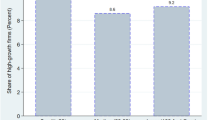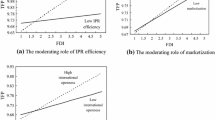Abstract
This paper introduces firm size in the analysis of the productivity spillovers of foreign direct investment. Our analysis of a panel of Romanian firms reveals two main findings: only medium-sized foreign firms generate spillovers, and domestic firms’ size is of limited importance to identify which firms absorb spillovers. To explain these findings, we show that large foreign firms are less embedded in the domestic economy because they are more likely to bring their own suppliers, import intermediate inputs and export their output. Smaller foreign firms lack the scale to transmit spillovers to domestic firms. Whereas foreign firms’ size adequately proxies for these spillover mechanisms, domestic firms’ size has an unclear relationship with the different mechanisms.






Similar content being viewed by others
Notes
Foreign presence also has a net positive impact on firm survival (Burke et al. 2008).
The EU criteria use employment and turnover thresholds, but we focus on employment only. The European Commission defines size classes using the following ceilings: micro firms have less than 10 employees and a turnover or balance sheet total of maximum 2 million Euro; small firms have less than 50 employees and a turnover or balance sheet total of maximum 10 million Euro; medium-sized firms have less than 250 employees and a turnover or balance sheet total of maximum 50/43 million Euro (http://ec.europa.eu/enterprise/policies/sme/facts-figures-analysis/sme-definition/index_en.htm).
A single issue of the database is a snapshot of the ownership information and firms that exit are quickly dropped from the database.
We use the definition formulated in the OECD Glossary of foreign direct investment (http://www.oecd.org/daf/inv/investment-policy/fdibenchmarkdefinition). In the supplementary materials, we show that our results still hold if we apply a more stringent definition of at least 50 % foreign participation.
In the supplementary materials, we show that results are not qualitatively affected by applying the slightly different Javorcik (2004) definition.
We follow Amiti and Konings (2007) to calculate investment from our data.
Introducing region and industry dummies is particularly important to our context. During the sample period, Romania is going through a transformation process because the country’s industrial structure was distorted due to communist preferences.
Downstream foreign entry could increase demand for intermediate products and result in scale economies. To separate this effect, the regression includes demand for intermediates calculated following Javorcik (2004) as \({\text{demand}}_{jt} = \sum\nolimits_{k} {a_{jk} *Y_{kt} }\) with a jk the IO-matrix coefficient indicating that in order to produce one unit of good k, a jk units of good j are needed. Y kt stands for industry k output deflated by an industry-specific deflator.
We find further support in the BEEPS 2005 questionnaire (cf. infra). Of the 33 small foreign firms interviewed in Romania, 30 answered yes to the question whether they operate locally, but only 16 answered yes to the question whether they operate nationally.
Within industry-year-size categories, foreign firms are matched to a domestic twin firm that shares characteristics with the foreign firm. The following variables are used to estimate the propensity score: lagged TFP level, lagged first-differenced TFP, lagged log of the number of employees and its square, lagged log of capital per worker and its interaction with age, age and age squared. Arnold and Javorcik (2009) provide a detailed analysis of the foreign TFP premium.
This does not preclude a role for technological superiority of foreign firms (Lenaerts and Merlevede, 2014).
Although initially Renault set out to continue cooperating with Dacia's local suppliers, eleven foreign suppliers of the firm were ‘asked’ to enter the Romanian market quickly to take over from the local suppliers which did not meet Renault's expectations.
Entry of large firms occurs in only 17 % of industry-year observations; of these 70 % is a single large foreign entrant, another 15 % is two large foreign entrants, and the remainder varies between 3 and 7 large foreign entrants.
This is a dummy variable that equals one when either a large or a medium-sized foreign firm enters, or both at the same time.
Industry-year pairs with zero entry of micro or small firms are limited. This caveat should be kept in mind for these results.
Gashi et al. (2014) for example use the full BEEPS dataset to study export behavior of SMEs in transition countries.
The 1999 survey is structured differently, and corresponding questions are hard to find; the 2009 survey is well beyond the time-period of our dataset.
The example of Dacia's former suppliers unable to live up to Renault’s expectations is also an indication of the limited absorptive capacity of these firms. This prevents them from benefiting from supply chain linkages with Renault.
References
Ackerberg, D., Caves, K., & Frazer, G. (2008). Structural Identification of Production Functions. mimeo.
Acs, Z., & Audretsch, D. (1990). Innovation and Small Firms. Cambridge, MA: MIT Press.
Acs, Z., Audretsch, D., & Feldman, M. (1994). R&D spillovers and recipient firm size. The Review of Economics and Statistics, 76(2), 336–340. doi:10.2307/2109888.
Aitken, B. J., & Harrison, A. E. (1999). Do domestic firms benefit from direct foreign investment? Evidence from Venezuela. American Economic Review, 89(3), 605–618. doi:10.1257/aer.89.3.605.
Alfaro, L., Chanda, A., Kalemli-Ozcan, S., & Sayek, S. (2010). Does foreign direct investment promote growth? Exploring the role of financial markets on linkages. Journal of Development Economics, 91(2), 242–256. doi:10.1016/j.jdeveco.2009.09.004.
Amiti, M., & Konings, J. (2007). Trade liberalization, intermediate inputs, and productivity: Evidence from Indonesia. American Economic Review, 97(5), 1611–1638. doi:10.1257/aer.97.5.1611.
Arnold, J., & Javorcik, B. S. (2009). Gifted kids or pushy parents? Foreign direct investment and plant productivity in Indonesia. Journal of International Economics, 79(1), 42–53. doi:10.1016/j.jinteco.2009.05.004.
Audretsch, D., & Keilbach, M. (2004). Entrepreneurship capital and economic performance. Regional Studies, 38(8), 949–959. doi:10.1080/0034340042000280956.
Blomström, M. (1986). Foreign investment and productive efficiency: The case of Mexico. Journal of Industrial Economics, 35(1), 97–112. doi:10.2307/2098609.
Bureau Van Dijk (2011). Amadeus database. http://www.bvdinfo.com/Products/Company-Information/International/Amadeus.aspx
Burke, A., Görg, H., & Hanley, A. (2008). The impact of foreign direct investment on new firm survival in the UK: Evidence for static versus dynamic industries. Small Business Economics, 31(4), 395–407. doi:10.1007/s11187-007-9065-y.
Caves, R. (1974). Multinational firms, competition and productivity in host-country markets. Economica, 41(162), 176–193. doi:10.2307/2553765.
Crespo, N., & Fontoura, M. (2007). Determinant factors of FDI spillovers—What do we really know? World Development, 35(3), 410–425. doi:10.1016/j.worlddev.2006.04.001.
Findlay, R. (1978). Some aspects of technology transfer and direct foreign investment. American Economic Review, 68(2), 275–279.
Gashi, P., Hashi, I., & Pugh, G. (2014). Export behaviour of SMEs in transition countries. Small Business Economics, 42(2), 407–435. doi:10.1007/s11187-013-9487-7.
Girma, S. (2005). Absorptive capacity and productivity spillovers from FDI: A threshold regression analysis. Oxford Bulletin of Economics and Statistics, 67(3), 281–306. doi:10.1111/j.1468-0084.2005.00120.x.
Griliches, Z., & Mairesse, J. (1995). Production functions: The search for identification. Harvard Institute of Economic Research working papers 1719, Harvard - Institute of Economic Research.
Haskel, J., Pereira, S., & Slaughter, M. (2007). Does inward foreign direct investment boost the productivity of domestic firms? Review of Economics and Statistics, 89(3), 482–496. doi:10.1162/rest.89.3.482.
Havranek, T., & Irsova, Z. (2011). Estimating vertical spillovers from FDI: Why results vary and what the true effect is. Journal of International Economics, 85(2), 234–244. doi:10.1016/j.jinteco.2011.07.004.
Havranek, T., & Irsova, Z. (2013). Determinants of horizontal spillovers from FDI: Evidence from a large meta-analysis. World Development, 42(C), 1–15. doi:10.1016/j.worlddev.2012.07.001.
Helpman, E., Melitz, M. J., & Yeaple, S. R. (2004). Exports versus FDI with heterogenous firms. American Economic Review, 94(1), 300–316. doi:10.1257/000282804322970814.
Javorcik, B. (2004). Does foreign direct investment increase the productivity of domestic firms? In search of spillovers through backward linkages. American Economic Review, 94(3), 605–627. doi:10.1257/0002828041464605.
Javorcik, B., & Spatareanu, M. (2005). Disentangling FDI spillover effects: What do firm perceptions tell us? In T. H. Moran, E. M. Graham & M. Blomström (Eds.), Does foreign direct investment promote development? US: Institute for International Economics. http://bookstore.piie.com/book-store/3810.html
Kokko, A., Tansini, R., & Zejan, M. (1996). Local technological capability and productivity spillovers from FDI in the Uruguayan manufacturing sector. Journal of Development Studies, 32(4), 602–611. doi:10.1080/00220389608422430.
Kuo, H., & Li, Y. (2003). A dynamic decision model of SMEs’ FDI. Small Business Economics, 20(3), 219–231. doi:10.1023/A:1022819206036.
Lenaerts, K., & Merlevede, B. (2012). Supply chain fragmentation and spillovers from foreign direct investment. Ghent University working paper: No. 12/822.
Lenaerts, K., & Merlevede, B. (2014). FDI spillovers and multinational firm heterogeneity. Ghent University working paper: No. 14/879.
Levinsohn, J., & Petrin, A. (2003). Estimating production functions using inputs to control for unobservables. Review of Economic Studies, 70(2), 317–341. doi:10.1111/1467-937X.00246.
Merlevede, B., Schoors, K., & Spatareanu, M. (2014). FDI spillovers and time since foreign entry. World Development, 56, 108–126. doi:10.1016/j.worlddev.2013.10.022.
Meyer, K. E., & Sinani, E. (2009). When and where does foreign direct investment generate positive spillovers? Journal of International Business Studies, 40(7), 1075–1094. doi:10.1057/jibs.2008.111.
Moulton, B. (1990). An illustration of a pitfall in estimating the effects of aggregate variables on micro units. The Review of Economics and Statistics, 72(2), 334–338. doi:10.2307/2109724.
Olley, S., & Pakes, A. (1996). Dynamics of productivity in the telecommunications equipment industry. Econometrica, 64(6), 1263–1297. doi:10.2307/2171831.
RSO. (2005). Statistical Yearbook. Bucharest: Romanian Statistical Office.
Sinani, E., & Meyer, K. E. (2004). Spillovers of technology transfer from FDI: The case of Estonia. Journal of Comparative Economics, 32(3), 1–22. doi:10.1016/j.jce.2004.03.002.
Vacek, P. (2010). Panel data evidence on productivity spillovers from foreign direct investment: Firm-level measures of backward and forward linkages. IES working paper 19/2010. IES FSV. Charles University.
WIIW. (2007). Industrial Database Eastern Europe. Vienna: Vienna Institute for International Economic Studies.
Author information
Authors and Affiliations
Corresponding author
Electronic supplementary material
Below is the link to the electronic supplementary material.
Rights and permissions
About this article
Cite this article
Lenaerts, K., Merlevede, B. Firm size and spillover effects from foreign direct investment: the case of Romania. Small Bus Econ 45, 595–611 (2015). https://doi.org/10.1007/s11187-015-9652-2
Accepted:
Published:
Issue Date:
DOI: https://doi.org/10.1007/s11187-015-9652-2




